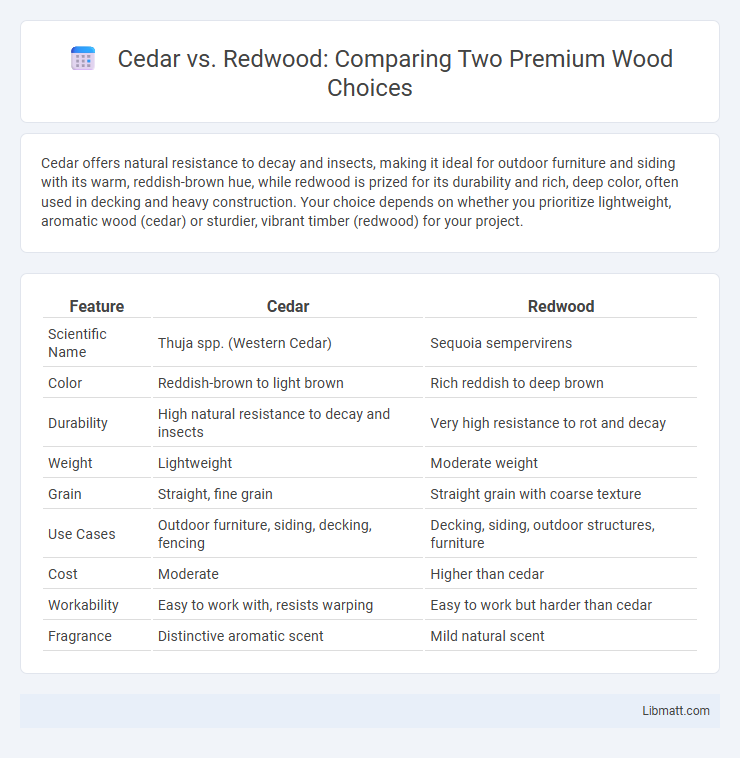Cedar offers natural resistance to decay and insects, making it ideal for outdoor furniture and siding with its warm, reddish-brown hue, while redwood is prized for its durability and rich, deep color, often used in decking and heavy construction. Your choice depends on whether you prioritize lightweight, aromatic wood (cedar) or sturdier, vibrant timber (redwood) for your project.
Table of Comparison
| Feature | Cedar | Redwood |
|---|---|---|
| Scientific Name | Thuja spp. (Western Cedar) | Sequoia sempervirens |
| Color | Reddish-brown to light brown | Rich reddish to deep brown |
| Durability | High natural resistance to decay and insects | Very high resistance to rot and decay |
| Weight | Lightweight | Moderate weight |
| Grain | Straight, fine grain | Straight grain with coarse texture |
| Use Cases | Outdoor furniture, siding, decking, fencing | Decking, siding, outdoor structures, furniture |
| Cost | Moderate | Higher than cedar |
| Workability | Easy to work with, resists warping | Easy to work but harder than cedar |
| Fragrance | Distinctive aromatic scent | Mild natural scent |
Overview: Cedar vs Redwood
Cedar and Redwood are both premium softwoods prized for their durability, natural resistance to decay, and rich reddish hues, making them popular choices for outdoor projects like decking and siding. Cedar typically offers a tighter grain and a more aromatic scent due to its oils, while Redwood provides greater structural strength and a slightly more uniform color that deepens with age. Your choice between Cedar and Redwood depends on specific needs such as appearance, durability, and climate resilience.
Botanical Differences
Cedar and redwood belong to different botanical families, with cedar classified under the Cupressaceae family and redwood under the Taxodiaceae family. Redwoods (Sequoia sempervirens) are known for their towering height and massive trunk diameter, while cedars (Cedrus species) have a more conical shape with distinct needle-like leaves arranged in clusters. Understanding these botanical differences can help you choose the right wood based on growth patterns, leaf structure, and natural habitat preferences.
Appearance and Color
Cedar wood typically showcases a warm reddish-brown hue with a fine, straight grain that develops a silvery gray patina over time when exposed to weather. Redwood exhibits a rich, deep red to pinkish tone with varying grain patterns ranging from straight to slightly wavy, offering a striking contrast with its natural sapwood that is lighter and almost white. Both woods provide distinctive colors and textures that enhance outdoor and indoor applications, with cedar often favored for its uniformity and redwood prized for its vibrant, bold coloration.
Durability and Longevity
Cedar wood is known for its natural resistance to decay, insects, and moisture, contributing to a lifespan of 15 to 30 years in exterior applications, depending on exposure and maintenance. Redwood exhibits superior durability due to its dense grain and high concentration of tannins, often lasting 20 to 40 years or more when properly cared for. Both woods offer excellent longevity, but redwood's enhanced resistance to fungal decay makes it a preferred choice for long-term outdoor projects.
Resistance to Decay and Insects
Cedar wood exhibits strong natural resistance to decay and insect infestations due to its high levels of thujaplicins and natural oils, making it ideal for outdoor applications. Redwood contains tannins that provide excellent durability against moisture and pests, though it is generally considered slightly less resistant than cedar. Both woods offer sustainable options for exterior projects requiring longevity and protection against environmental factors.
Workability and Ease of Installation
Cedar offers superior workability due to its lightweight and straight grain, making it easier to cut, shape, and install with basic tools. Redwood, while also workable, tends to be denser and may require more effort during installation, especially for larger projects. Both woods resist splitting well, but cedar's softer texture generally allows for faster and smoother handling on the job site.
Cost Comparison
Redwood tends to be pricier than cedar due to its durability and natural resistance to decay, making it a premium choice for outdoor projects like decking and fencing. Cedar offers a more budget-friendly option while still providing good weather resistance and aesthetic appeal. Your decision may hinge on balancing the initial cost against long-term maintenance and lifespan.
Environmental Impact and Sustainability
Cedar offers a lower environmental impact due to its faster growth rate and widespread availability, making it a more sustainable choice for timber products. Redwood, while prized for its durability and natural resistance to decay, grows more slowly, leading to longer harvest cycles and potential concerns about forest depletion. Sustainable forestry practices, such as certification by the Forest Stewardship Council (FSC), are essential in minimizing the ecological footprint of both cedar and redwood harvesting operations.
Best Uses: Outdoor vs Indoor Applications
Cedar is ideal for outdoor applications due to its natural resistance to decay, insects, and moisture, making it perfect for decks, fences, and outdoor furniture. Redwood is favored for both outdoor and indoor use because of its stability, rich color, and smooth finish, which enhances indoor paneling, cabinets, and decorative woodwork. Your choice depends on whether durability in harsh weather or aesthetic appeal indoors is your priority.
Maintenance Requirements
Cedar requires minimal maintenance due to its natural oils that resist rot and insect damage, making it ideal for low-maintenance outdoor projects. Redwood demands regular sealing or staining to maintain its rich color and protect against weathering and UV damage. Both woods benefit from periodic cleaning to extend their lifespan, but cedar typically offers a more hassle-free experience over time.
Cedar vs Redwood Infographic

 libmatt.com
libmatt.com